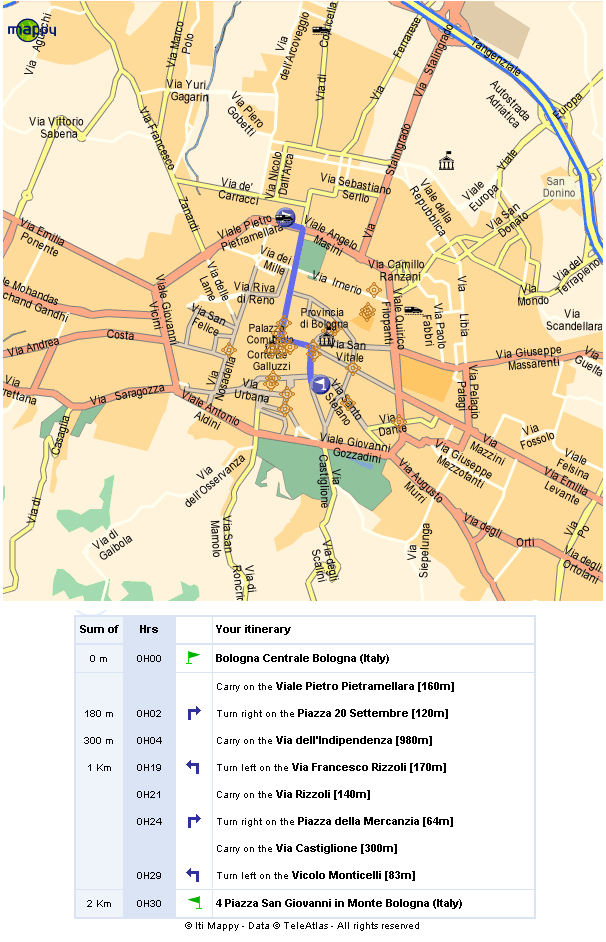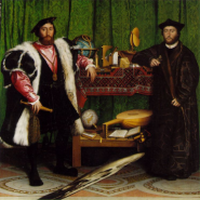
Conference Location
History
|
In the 4th century BC the city was conquered by the Boii, a Gallic tribe, whence the ancient name Bononia of the Roman colony founded in c. 189 BC. The settlers included 3,000 Latin families led by the consuls Lucius Valerius Flaccus, Marcus Atilius Seranus, and Lucius Valerius Tappo. The building of the Via Aemilia in 187 BC made Bologna a road hub, connected to Arezzo through the Via Flaminia minor and to Aquileia through the Via Aemilia Altinate. The Via Emilia still runs straight through the city under the changing names of Strada Maggiore, Rizzoli, Ugo Bassi, and San Felice. |
 |
In 88 BC the city became a municipium: it had a rectilinear street plan with six cardi and eight decumani (intersecting streets) which are still discernible today. During the Roman era, its population varied between c. 12,000 to c. 30,000. At its peak, it was the second city of Italy, and one of the most important of all the Empire, with various temples and baths, a theatre, and an arena. Pomponius Mela included Bononia among the five opulentissimae ("richest") cities of Italy. Although fire damaged the city during the reign of Claudius, the Roman Emperor Nero rebuilt it in the first century.
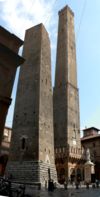
|
After a long decline, Bologna was reborn in the 5th century under bishop Petronius, who traditionally built the church of S. Stefano. After the fall of Rome, Bologna was a frontier stronghold of the Exarchate of Ravenna in the Po plain, and was defended by a line of walls which however did not enclose most of the ancient ruined Roman city. In 728, the city was conquered by the Lombard king Liutprand, becoming part of the Lombard Kingdom. The German newcomers formed a district called "addizione longobarda" near the complex of S. Stefano, where Charlemagne stayed in 786. In the 11th century Bologna began to grow again as a free commune, joining the Lombard League against Frederick Barbarossa in 1164. In 1088 the Studio was founded, now the oldest university in Europe, which could boast notable scholars of the Middle Ages like Irnerius, and, among its students, Dante, Boccaccio and Petrarca. In the 12th century the expanding city needed a new line of walls, and the original Roman ramparts were supplanted by a high medieval system of fortifications, remains of which are still visible, and finally by a third and final set of ramparts built in the 13th century, of which numerous sections survive. Over twenty medieval defensive towers, some of them leaning precariously, remain from the over two hundred that were constructed in the era preceding the security guaranteed by unified civic government |
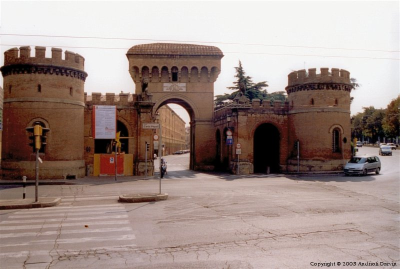
|
In 1256 Bologna promulgated the Legge del Paradiso ("Paradise Law"), which abolished feudal serfdom and freed the slaves using public money. At that time the city centre was full of towers (perhaps 180), built by the leading families, notable public edifices, churches, and abbeys. In 1294, Bologna was perhaps the fifth or sixth largest city in Europe, after Cordoba, Paris, Venice, Florence, and, probably, Milan, with 60,000 - 70,000 inhabitants. Like most Italian cities of that age, Bologna was torn by internal struggles, which lead to the expulsion of the Ghibelline family of Lambertazzi in 1274. After being crushed in the Battle of Zappolino by the Modenese in 1325, Bologna began to decay and asked the protection of the Pope at the beginning of the 14th century. In 1348, during the terrible European pestilence, about 30,000 inhabitants died. |
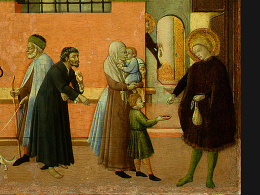
|
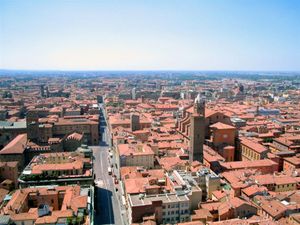 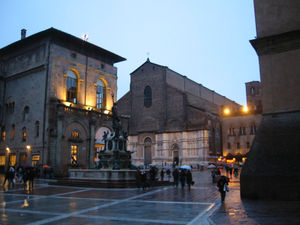 |
After the happy years of the rule of Taddeo Pepoli (1337-1347), Bologna fell to the Visconti of Milan, but returned to the Papal orbit with Cardinal Gil de Albornoz in 1360. The following years saw an alternation of Republican governments like that of 1377, which was responsible for the building of the Basilica di San Petronio and the Loggia dei Mercanti, and Papal or Visconti restorations, while the city's families engaged in continual internecine fighting. In the middle of the 15th century the Bentivoglio family gained the rule of Bologna, reigning with Sante (1445-1462) and Giovanni II (1462-1506). This period was a flourishing one for the city, with the presence of notable architects and painters who made Bologna a true city of art. During the Renaissance, Bologna was the only Italian city that allowed women to excel in any profession. Women there had much more freedom than in other Italian cities; some even had the opportunity to earn a degree at the university. Giovanni's reign ended in 1506 when the Papal troops of Julius II besieged Bologna and sacked the artistic treasures of his palace. From that point on, until the XVIII century, Bologna was part of the Papal States, ruled by a cardinal legato and by a Senate which every two months elected a gonfaloniere (judge), assisted by eight elder consuls. The city's prosperity continued, although a plague at the end of the 16th century reduced the population from 72,000 to 59,000, and another in 1630 to 47,000. The population later recovered to a stable 60,000-65,000. In 1564 the Piazza del Nettuno and the Palazzo dei Banchi were built, along with the Archiginnasio, the seat of the University. The period of Papal rule saw the construction of many churches and other religious establishments, and the renovation of older ones. Bologna had ninety-six convents, more than any other Italian city. Artists working in this age in Bologna established the Bolognese School that includes Annibale Carracci, Domenichino, Guercino and others of European fame. |
With the rise of Napoleon, Bologna became the capital of the Repubblica Cispadana and, later, the second most important centre after Milan of the Repubblica Cisalpina and the Italian Kingdom. After the fall of Napoleon, Bologna suffered the Papal restoration, rebelling in 1831 and again 1849, when it temporarily expelled the Austrian garrisons which commanded the city until 1860. After a visit by Pope Pius IX in 1857, the city voted for annexation to the Kingdom of Sardinia on June 12, 1859, becoming part of the united Italy.
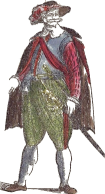
|
|
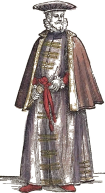
|
Presently, Bologna is a city of 400.000 inhabitants, with a further 1 million in its metropolitan area. It is a very important railway and motorway hub in Italy. Bologna and its metropolitan area have several important industries (Ducati, Maserati, Lamborghini) in the fields of mechanics, foods, and electronics, important retail and wholesale trade (the "Centergross" in the northern metropolitan area, built in 1973, was the largest in Europe for several years), and the first Italian vegetable and fruit market. Bologna also has important monuments, museums, and a rich cultural life.

|
Typical for Bologna are the elegant and extensive arcades (or porticos), for which the city is famous. In total, there are some 38 kilometres of arcades in the city's historical center[1] (over 45 km in the city proper), which make it possible to walk for long distances sheltered from rain, snow, or hot summer sun. The Portico of San Luca, the longest in the world (3.5 km, 666 arcades) connects the Porta Saragozza (one of the twelve gates of the ancient walls built in the middle ages, which circled a 7.5 km part of the city) with the San Luca Sanctuary, on Colle della Guardia, over the city. More city views can be found here. If you want to venture further then I can recommend visitng Modena or Siena. |
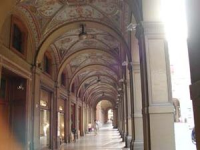
|
Parts of this text were copied from 
Conference Venue
The University of Bologna, founded in 1088, is the oldest existing university in Europe, and was an important centre of European intellectual life during the Middle Ages, attracting scholars from throughout Christendom. A unique heritage of medieval art, exemplified by the illuminated manuscripts and jurists' tombs produced in the city from the thirteenth to the fifteenth century, provides a cultural backdrop to the renown of the medieval institution. The Studium, as it was originally known, began as a loosely organized teaching system with each master collecting fees from students on an individual basis. The location of the early University was thus spread throughout the city, with various colleges being founded to support students of a specific nationality.
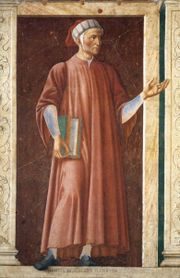 |
In the Napoleonic era, the headquarters of the university were moved to their present location on Via Zamboni (formerly Via San Donato), in the north-eastern sector of the city centre. Today, the University's 23 faculties, 68 departments, and 93 libraries are spread across the city and include four subsidiary campuses in nearby Cesena, Forlì, Ravenna, and Rimini. Noteworthy students present at the university in centuries past included Dante, Petrarch, Thomas Becket, Pope Nicholas V, Erasmus of Rotterdam, and Copernicus. Laura Bassi, appointed in 1732, became the first woman to officially teach at a college in Europe. In more recent history, Luigi Galvani, the discoverer of biological electricity, and Guglielmo Marconi, the pioneer of radio technology, also worked at the University. The University of Bologna remains one of the most respected and dynamic post-secondary educational institutions in Italy. |
|
To this day, Bologna is still very much a university town, and the city's population swells from 400,000 to over 500,000 whenever classes are in session. This community includes a great number of Erasmus, Socrates, and overseas students. Several American colleges and universities, such as Brown University, Dickinson College, and the University of California, sponsor exchange programs. There is also a consortium of several universities, the Bologna Cooperative Studies Program, that is headed by Indiana University. The University of Denver also has an embedded study abroad program in Bologna, in coordination with the Center for Civic Engagement. In addition the Johns Hopkins University School of Advanced International Studies maintains a permanent campus in the city. Today the University of Bologna controls twenty-three faculties: Agricultural sciences; Industrial Chemistry; Economics; Pharmacy; Law; Engineering; Literature and philosophy; Foreign languages and literatures; Medicine and surgery; Veterinary medicine; Sciences of education; Mathematics, physics and natural sciences; Sciences of physical education; Political Sciences; and Statistics; only in Cesena: Architecture; Psychology; and only in Ravenna: Conservation of cultural heritage. |
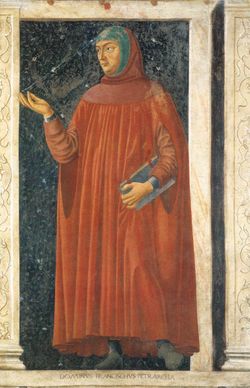
|
The actual conference building
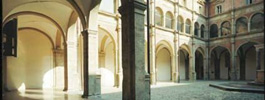 |
The GAMEON 2007 conference will be held in the magnificent "Aula Prodi" conference hall within the church of S. Giovanni in Monte (see the picture on the left of the cloister on the ouside of the Aula Prodi) |
|
"Aula Prodi" conference hall P.zza S. Giovanni in Monte, 2 I-40124 Bologna  Tel: +39 051 209 7600 Tel: +39 051 209 7600 Fax: +39 051 209 7620 Fax: +39 051 209 7620 E-Mail: info.distoriche@unibo.it E-Mail: info.distoriche@unibo.it |
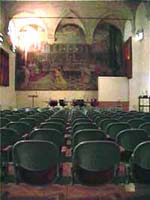 |
How to get to the actual venue can be found here. This link also contains other useful information on travel to and from the venue.
How to get to Bologna 
By Plane
|
When landing in Bologna, you will arrive at Guglielmo Marconi International Airport. At the airport, which is about 6km from the city centre you can transfer to a bus, take a taxi or rent a car. A 3D Map and an overview map of the airport are featured below. |
By Train
|
Both international and or local train connections information to Bologna can be found here: Italian Railways. An overview map of the Italian rail network is featured below. |
By Bus
|
AEROBUS - BLQ shuttle service (Terminal-Raiway Station) An overview map of the bus stops and the stops at the station are featured below. |
By Taxi
|
Taxi information: (COTABO 051/372727 - CAT 051/534141) or Info Taxi |
By Car
|
The Airport is about 6 Km far from Bologna city centre and and thus a 5 minute drive from motorway exits: Exit No. 4 of Bologna by-pass road (Tangenziale). If you are coming by car to Bologna you can take: For further motorway information, visit this site: Autostrade per l'Italia See the Motorway maps featured below. |
On Foot
|
When you are in Bologna itself, the city centre, is at walking distance from the conference site. See this link and the map below. |
Detailed Maps
Airport Maps
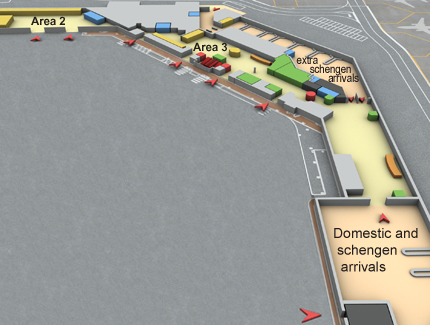
3D View of the Arrival Hall of Bologna Airport
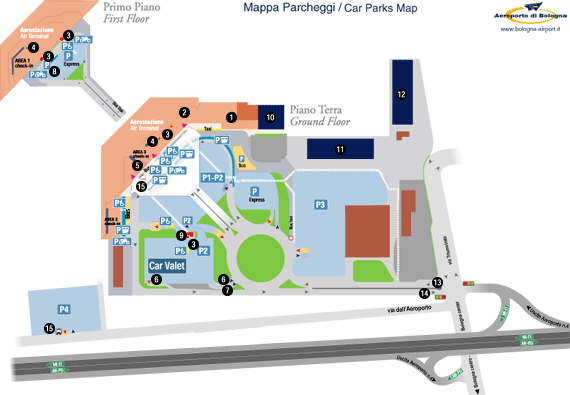
Overview Map of Bologna Airport
Railway Map of Italy
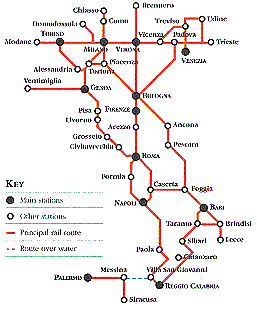
Travel by Bus Maps
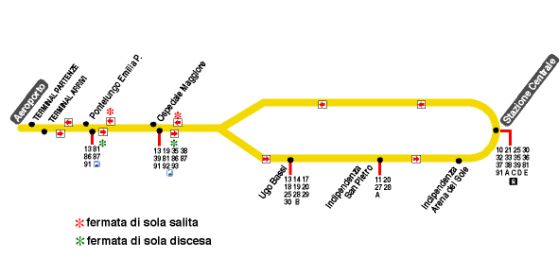
Bus Route from the Airport
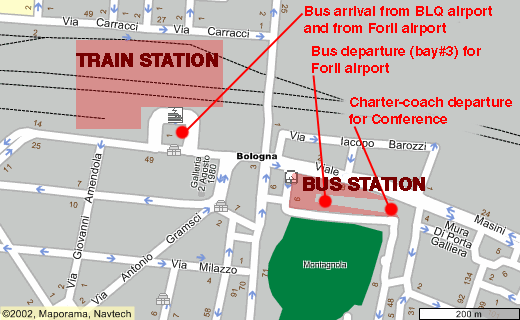
Map of the Bus Terminal in Bologna -Please ignore charter departure for conference link
Motorway Maps
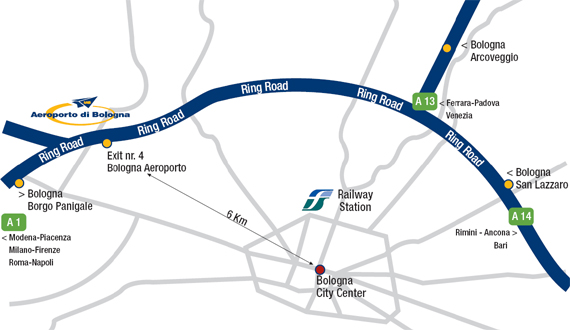
Motorway Connection between Bologna City Centre and Bologna Airport
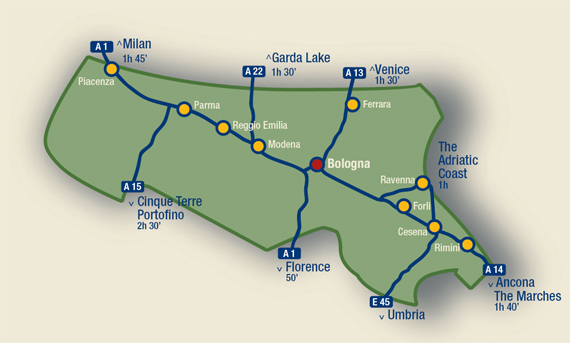
Map of Emilia-Romagna: main motorway connections with Bologna
Pedestrian Map
